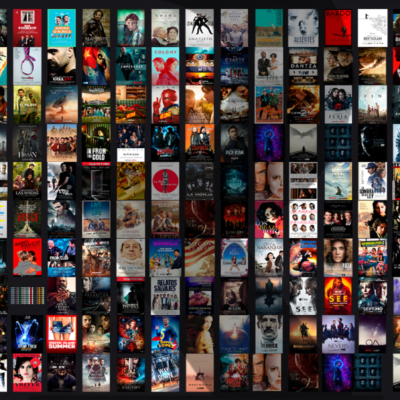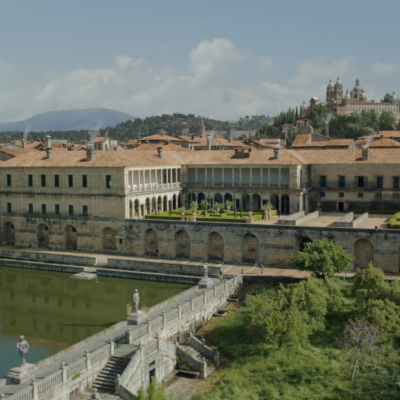Introducing the Crowd Department⚡️

A fascinating journey through the world of Crowd, exploring from the creative process, the most important needs and challenges faced by Oscar Marquez, Crowd Supervisor at El Ranchito, along with his team, Unai Ibabe and Pere Sendra, when realizing their projects.
- Unai Ibabe, Oscar Marquez y Pere Sendra
what does your work consist of?
The Crowd department was created at El Ranchito as a necessity due to the increasing number of projects requiring crowd. Our department is halfway between the FX department and the Animation department. The day-to-day work is very varied, as we are in charge of doing from the modeling and lookdev of the characters to the creation of the behaviors of the agents in the simulations, as well as variations of the mocaps in a more procedural way. In addition, depending on the project's requirement, we generate the grooming and wardrobe simulation, as we can more and more frequently bring the crowd agents closer to the camera.
- Megan Leavey
What tools do you use at El Ranchito to create crowd?

Game of Thrones. Season 7
Since season 7 of Game of Thrones we have used Golaem, a Maya’s software. It allows us to achieve high quality in excellent production times, and it is also very flexible because, due to its procedurality, we can work on the assets and shots almost simultaneously without affecting delivery times. In addition, we can pass our caches and render them in Maya and Houdini, which opens many doors for the department's future.
Is artificial intelligence transforming the Crowd creation process?
Of course it is. Any crowd software right now is based on algorithms of people's social behaviors. There is a lot of AI-based motions generation software, which allows us to make very good variations and blendings with the data we have so far. It's a matter of time before we can introduce a behavior of people walking down the street with a few commands and make them say hello, stop to talk or interact with each other, as well as do all kinds of texture variations or clothing modeling, as needed.
How has the process evolved over the years?
Although a crowd simulation is nothing more than a few particles in space that move with different algorithms, and each of them can represent an agent doing a specific action. Over the years, we have managed to make crowd simulations less and less expensive and faster with several tools that make the day to day easier to manage. For example, tools to make the placement of the agents in the scenes, to make procedural variations of the rig as well as variations of the clothes and textures, or to make more and more visual the behavior of each of the agents to know which are their behaviors and their logics. If we can also see it represented in GPU in real time, with dynamics, cloth simulation, etc., then the times in which we can make high-quality shots are becoming shorter each time.
What has been the most difficult job you have had to do at El Ranchito?

Game of Thrones. Season 8
It is hard to choose just one project because each show is challenging, either because the agents are close to the camera or because the simulations are complex. We always try to innovate something within the department. In Season 8 of Game of Thrones we had to simulate a wave of Wildlings approaching some troops and colliding. That allowed us to try many techniques and ways to make a wave of zombies come to the camera with ragdolls, motions, and animation mixing. It was a very long and expensive challenge to control height, speed, number of agents, and their collisions so close to the camera.
What are the technical limitations you have regarding the number of crowd in a shot?
More than a technical limitation, I would say that there is a hardware limitation because if the management of the caches is optimal and the asset is optimized for the distance in which it will be shown in the shot, we have not found any shot that we have not been able to render. In Game of Thrones we have rendered images with more than one hundred thousand agents in different layers and caches. At the same time, it is true that the simulation of clothing, when we are very close to the camera, costs a lot, and we have even had simulations with only 50 agents for more than 18 hours.
When does the crowd stop being considered as such to be considered animation?
As soon as they ask for a specific acting with the possibility of changes, it is more profitable to pass an agent to animation and to animate by hand than to make iterations between two departments, the Animation department to retouch and the Crowd department to simulate. It sometimes happens that, for whatever reason, it is decided that an agent has a specific acting role at some point in the shot, and that is when we have the support of the animation department. That agent is propagated to another department.
When do you use crowd or when do you use layer multiplication in compositing?
Typically, the VFX Supervisor decides when shooting, considering the extras that may be needed during the shooting, which can be several layers. But we have had to fill with crowd plates that have not worked for different reasons. It depends on the project. In the briefing, we decide if the plates will be enough to fill the shot.
- see. Season 2
What training is required to work in this specialty?
Nowadays, there is very little training in crowd, and there are very few experienced artists, especially if we look at it from the needs of El Ranchito, where we want to have control of our assets as well as our motions and simulations. We don't have departmentalized modeling, lookdev, grooming, etc... That leads us to be very versatile in different artistic aspects like modeling, lookdev, or grooming, to something more technical like crowd and clothing simulations, or even to make some internal tools in Python. A generalist who desires to work on many different tasks would be a good match.





